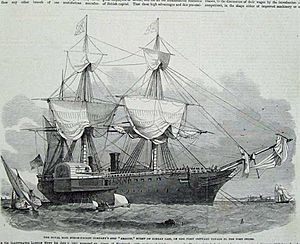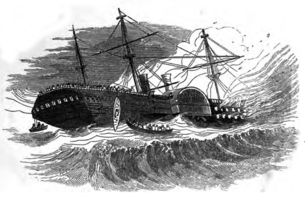RMS Amazon (1851) facts for kids

Contemporary engraving of Amazon
|
|
Quick facts for kids History |
|
|---|---|
| Name | Amazon |
| Namesake | Amazon River |
| Owner | |
| Operator | |
| Builder | R & H Green, Blackwall Yard, London |
| Laid down | 1 September 1850 |
| Launched | 28 June 1851 |
| Maiden voyage | 2 January 1852 |
| Homeport | Southampton |
| Fate | Burnt and sank 4 January 1852 |
| General characteristics | |
| Tonnage | 2,256 NRT |
| Length | 300 ft (91 m) |
| Beam | 42 ft (13 m) over paddle boxes |
| Draught | 21 ft 7 in (6.58 m) |
| Installed power | 800 hp at 14 rpm |
| Propulsion |
|
| Sail plan | 3-masted barque |
| Speed |
|
| Capacity | 50 passengers |
| Crew | 112 |
| Notes | sister ships: Demerara, Magdalena, Orinoco & Paraná |
The RMS Amazon was a special kind of ship called a Royal Mail Ship. She was made of wood and had three masts like a sailing ship (a barque). She also had powerful paddle wheels to move her through the water. The Amazon was the first of five similar ships built for the Royal Mail Steam Packet Company. Her job was to carry mail and passengers between Southampton, England, and the Caribbean islands.
Contents
Building a Wooden Giant
By the 1850s, ships made of iron and powered by screws were becoming more common. However, the Admiralty, which oversaw mail ships, wanted them to have wooden hulls. So, the Royal Mail Steam Packet Company ordered the Amazon and her four sister ships to be built from wood.
The Amazon was built by R & H Green at Blackwall Yard in London.
- Her keel (the main bottom part of the ship) was laid on September 1, 1850.
- She was launched into the water on June 28, 1851.
- Her engines were built by Seaward and Capel.
- She had two large side-lever steam engines.
- These engines produced 800 hp and turned the paddle wheels at 14 revolutions per minute.
- The ship was about 2,900 GRT tons.
First Voyage and a Terrible Fire
The Amazon was the first of her sister ships to begin service. In December 1851, she arrived in Southampton to get ready for her very first journey.
- She loaded 1,000 tons of coal for her engines.
- She also took on hundreds of tons of other goods.
- Her strong room held valuable items like 500 bottles of mercury and £20,000 worth of gold and silver.
- The total value of her cargo was estimated at about £100,000.
- Like many ships back then, she carried farm animals on deck and hay to feed them.
On Friday, January 2, 1852, the Amazon set sail for the Caribbean. Captain William Symons was in command.
- She carried mail and 50 passengers.
- Within the first 24 hours, her engine bearings became too hot twice, forcing the ship to stop.
- On Sunday, January 4, around 12:40 PM, smoke was seen coming from a hatch near the front of the ship.
Captain Symons and his chief officer quickly organized the crew to fight the fire with buckets and a hose.
- Men tried to move the hay away from the fire.
- But after only two bales were moved, the rest of the hay caught fire.
- The fire spread very quickly.
Captain Symons ordered the engines to be stopped and the lifeboats to be launched.
- The mail boat was lowered with 25 people inside.
- But the sea was rough, and the ship was still moving.
- The boat was swamped by waves, and everyone in it was lost.
- The fire was now so big that no one could reach the engine room to stop the engines.
- Captain Symons turned the ship so the wind was behind it. This helped slow the fire from spreading to the back of the ship.
- However, it also made the ship go faster, making it even harder to launch the boats safely.
More boats were launched:
- The pinnace (a small boat) was lowered. Before it could be fully unhooked, a big wave hit it, throwing everyone into the water.
- A second cutter boat was also swamped by a wave, and only two people stayed in it.
- The starboard lifeboat was successfully launched, and 16 people got away in it.
- The dinghy (a very small boat) was also launched successfully with five people.
The fire grew worse and could not be controlled.
- The starboard lifeboat rescued the five people from the dinghy.
- They tried to go back to the burning ship to save more people.
- But the waves were too dangerous, so they had to leave.
- The Amazon was still moving, rocking in the rough sea. Captain Symons and his crew bravely tried to keep her steady.
- By 4:00 AM, the fire caused the ship's foremast and mainmast to fall.
- At 5:00 AM, the ship's magazine (where explosives were stored) exploded.
- Her mizzen mast also fell as the deck collapsed.
- The ship's funnels glowed red-hot from the intense heat.
- About 30 minutes later, the Amazon sank. This happened about 110 miles (180 km) west-south-west of the Isles of Scilly.
Rescue and Aftermath
Thankfully, some survivors were found:
- At 10:30 AM, the brig Marsden rescued the 21 people in the starboard lifeboat. They were taken to Plymouth.
- The Dutch ship Gertruida rescued 7 passengers and 17 crew members. They were taken to Brest.
- Another Dutch ship, Hellechina, rescued 13 more survivors. They were transferred to a British ship and landed at Plymouth.
- The steamship Harbinger also rescued some people.
In early February, a part of the Amazon's charred wooden timbers washed ashore at Falmouth.
Reports say that between 105 and 115 people died in the disaster. Among them were famous writers like Elliot Warburton and Gabriel Ferry.
- Queen Victoria and Prince Albert helped start a national fundraising effort.
- This money was given to the families who lost loved ones and to the survivors.
An investigation was held to find out what caused the fire.
- The investigation could not figure out exactly how the fire started.
- Some thought it might have started in the engine room because the engine bearings kept getting too hot.
- However, the engines continued to run even as the fire spread, which made this theory less certain.
Because of the Amazon's tragic loss, the Admiralty changed its mind about wooden hulls for mail ships. The very next ship ordered by the Royal Mail Steam Packet Company, the RMS Atrato, was built with a strong iron hull instead.
Images for kids



